Vintage Cable Box June 1984: Woody Allen Retrospective

Everybody hates Woody Allen. Don’t they? Comedy genius and filmmaker until January of 1992, then he becomes shit, worse than shit. I hate getting into this, but it’s strange how the cancel culture caravan comes around for the little guy every five years or so. He bounces back, they come after him again, rinse and repeat. It just gets worse and worse.
After Polanski, Woody was the minotaur of the combined #metoo and Time’s Up movements. Even though none of his actions had any bearing or influence in the modern Hollywood sexual dysfunction. People had this idea of Woody Allen seducing a little girl, maybe even attacking her. In reality, Soon-Yi was a consenting adult, the adopted daughter of Mia Farrow and André Previn, in no way related to Woody, not his adopted stepdaughter, and they fell in love.
They married in 1997. They’re still together. Yes, he spurned Mia. Yes, his actions could be considered questionable, but the witch-hunt that followed (and still continues to this day) doesn’t hold a candle to the commonplace shenanigans of current-day Hollywood. Woody’s hardly a pig. The 1984 HBO/Cinemax guide calls him a “Master of Comedy.” That’s how we looked at him in 1984, and I’m still comfortable seeing him that way. His recent work is still fresh and funny, inciteful and moving, I don’t care what anybody says.
A Midsummer Night’s Sex Comedy, 1982 (Woody Allen), Orion Pictures
“Marriage is the death of hope.”
Born a little too late to appreciate Woody Allen’s early slapstick comedy, and then the easy transformation to the more thoughtful romantic comedy for which he would become synonymous, A Midsummer Night’s Sex Comedy arrived on cable television at a time with which I would most identify: a middle period in his career that would introduce his new muse at the time: Mia Farrow.
A brilliant but under-utilized actress in her own right, she would receive the lion’s share of attention for her work (and unfortunately, her personal life) with Allen. The movie was unfairly maligned as audience enthusiasm dipped after the autobiographical Stardust Memories (1980). Allen plays a neurotic (of course) inventor, Andrew, married to the beautiful Adrian (Mary Steenburgen) whose cousin, college professor Leopold (José Ferrer) and his fiancée, Ariel (Farrow) are set to join them at their country home for the weekend.
Among his startling inventions and flying machines, Andrew has created what he calls a “spirit ball” (a kind of magic lantern), which can communicate with ghosts. Andrew’s friend, Max (Tony Roberts) is also invited, and he brings his latest girlfriend, the youthful and sexually active Dulcy (Julie Hagerty). Andrew’s sex life with his wife is waning. He keeps trying to initiate sex with her, but Adrian feels as though she might be frigid.
Andrew discovers that Leopold’s fiancée was an old flame he never quite got over. Andrew secretly covets Maxwell’s ease with women. He cries to him about his lack of sex drive. Maxwell recommends hypnosis. Leopold arrives with Ariel, and takes an immediate dislike to Maxwell, who starts to put the moves on Ariel. Adrian displays jealousy at the sight of her.
When she confronts Andrew, he lies that he never loved her. Dulcy and Leopold develop a mutual attraction to each other, while Ariel and Andrew take baby-steps to rekindle their romance. Maxwell confesses his love for Ariel to Andrew. He wants Andrew to escort Ariel for a late-day rendezvous. Leopold tells Dulcy he is enamored of her, and they arrange their own meeting time.
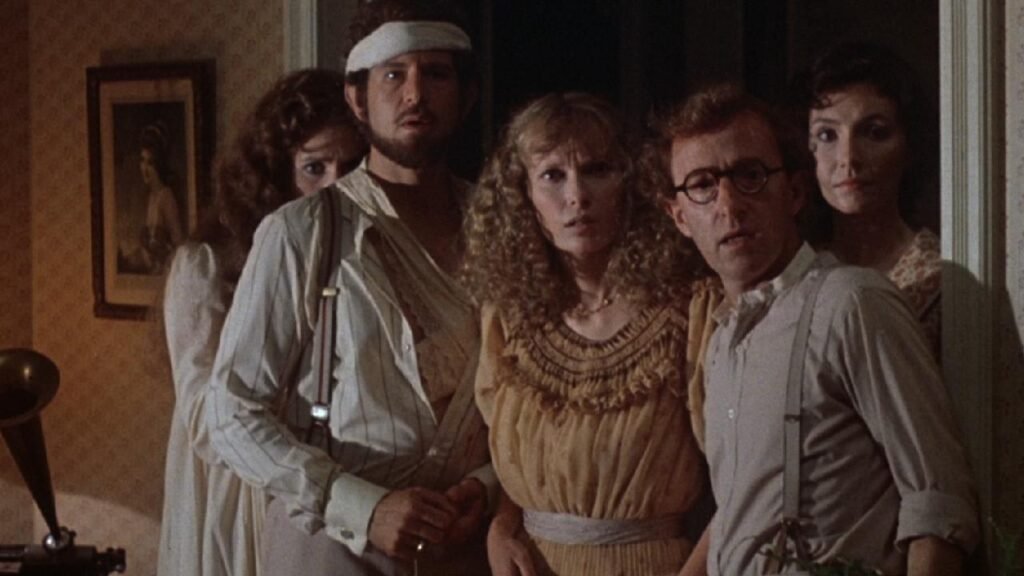
Adrian seeks sexual advice from Dulcy, while Andrew consummates his desire for Ariel. While Leopold is a worldly man of science who disbelieves notions of a spirit world, Ariel is earthy and bohemian, igniting the interest of both Maxwell and Andrew. Maxwell and Leopold nearly come to blows and Maxwell attempts suicide at the thought of their impending marriage.
Before the weekend is over, Maxwell will be shot through the heart with an arrow intended for Andrew, and Leopold will die in the throes of passion and his spirit will take up residence in the woods. This contrived plot very much reminds me of Allen’s Manhattan (1979) wherein these dynamics (and soap-opera-style contrivances) are played against the backdrop of a perfect city, or a sumptuous, wooded meadow, but lacking the epic qualities and instead embracing what Allen has referred to as “intermezzo.”
This is an unusual period-piece (turn of the century) that, if anything else, demonstrates Allen’s skill at dialogue that needs no particular span of centuries in order to be worthwhile. Images of sprites, spirits, and pixies are conjured by Allen’s characters in the midst of his typical sexual turmoil.
Gordon Willis’ photography is exceptional, and against the grain of his typically “darker” movies like The Godfather, Klute, and The Devil’s Own. Lush fields and forestry, and gorgeous specimens of nature are given such a beautiful treatment that I was surprised he never received nominations for this work in this movie. He would receive a much-deserved nomination a year later for Allen’s Zelig.
Everything You Always Wanted to Know About Sex* (*But Were Afraid to Ask), 1972 (Woody Allen/Gene Wilder/Louise Lasser) United Artists
“Before you know it, the Renaissance will be here and we’ll all be painting.”
Gene Wilder once stated in an interview that the roles he would be best remembered for were Willy Wonka (of course, we all remember Willy Wonka) and the guy who has a clandestine love affair with a sheep. Very early on in his career, he was ready to hang it up. The Producers was not a huge success upon initial release. The next year, he made a movie titled Quackser Fortune Has a Cousin in the Bronx with Margot Kidder.
That movie also flopped. Willy Wonka would complete the trifecta. These three movies would develop a tremendous cult following in subsequent years. Wilder took the role of Dr. Jerome Ross, a G.P. from Jackson Heights who falls in love with an (underage) Armenian sheep named Daisy. The whole thing plays out like a completely straight television melodrama or a soap opera, and that’s what makes it hilarious.

This (and the b-movie homage about the giant breast rampaging the countryside) are the two most memorable vignettes in Woody Allen’s in-name-only adaptation of Dr. David Reuben’s popular sex and self-help tome, Everything You Always Wanted to Know About Sex* (*But Were Afraid to Ask). A close runner-up has anxious sperm (one of them played by Allen) getting ready to paratroop into a womb.
Think of it less as an adaptation and more as Woody Allen’s answers to specific questions, such as Do Aphrodisiacs Work? or Are Transvestites Homosexuals? This is a clever yet silly (maybe even stupid) take on sexuality in the early ’70s, with an all-star cast (including Burt Reynolds and Tony Randall) to boot.
Love and Death, 1975 (Woody Allen/Diane Keaton) United Artists
“To love is to suffer. To avoid suffering one must not love. But then one suffers from not loving. Therefore, to love is to suffer; not to love is to suffer; to suffer is to suffer. To be happy is to love. To be happy, then, is to suffer, but suffering makes one unhappy. Therefore, to be unhappy, one must love or love to suffer or suffer from too much happiness. I hope you’re getting this down.”
I wasn’t much for Tolstoy or Dostoevsky when I was 11 years old, so I was grateful to Woody Allen for making all this heavy stuff palatable. I can’t imagine he sat down and turned those pages to make his spoof, Love and Death, or to make Tolstoy “funny” in some way. You’d have to know the material backward and forward, understand the relationships, and put it all in the context of the 19th century and the Napoleonic Wars.
He writes his standard characters (the lovelorn klutz, the object of desire, jealous rivals, friends, and suitors) and places them inside Tolstoy’s War and Peace. As with A Midsummer Night’s Sex Comedy, Allen hasn’t a care for accuracy, historical relevance or era-specific dialogue. Ghislain Cloquet’s photography of the French and Hungarian countryside is gorgeous.
Love and Death, along with Manhattan, and Sex Comedy are possibly the most beautifully shot of all of Allen’s films. In Love and Death, he inhabits Boris Grushenko, ne’er-do-well intellectual who engages in ultra-philosophical conversations with his cousin, Sonja (Diane Keaton), with whom he is secretly in love. He is conscripted into the war with France.
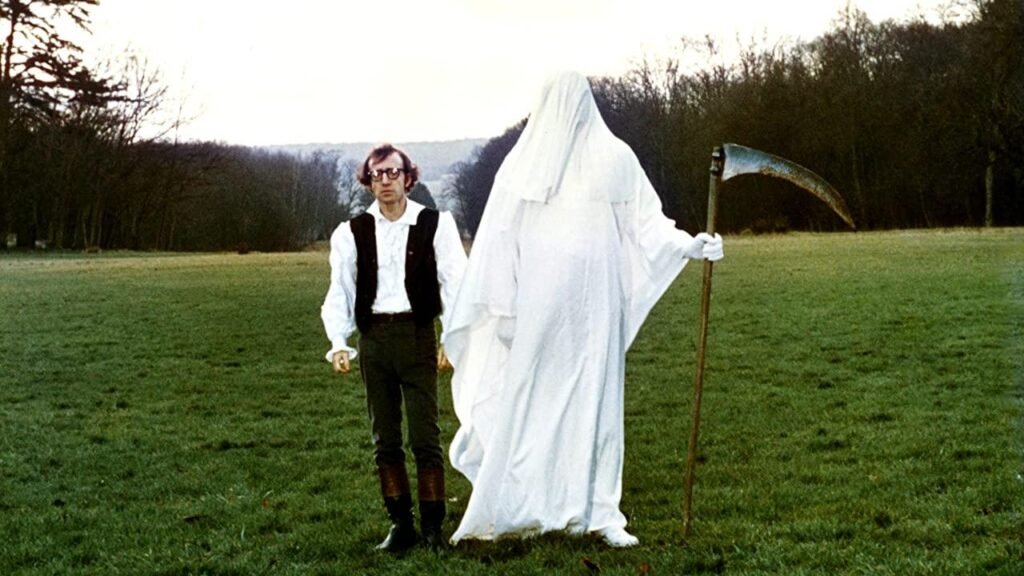
His popular brother, Ivan, is killed (bayoneted to death by a Polish conscientious objector), and he becomes an accidental hero. Returning home, he marries Sonja after surviving a duel. For a time, they have a happy life until Napoleon invades once again. Sonja concocts a plot to assassinate Napoleon (James Tolkan). It’s amazing to me how much happens in a slim 85-minute running time!
It almost feels like a Cliff’s Notes version of a Russian war epic. This is an interesting transitional phase. He was still doing the goofy comedy, but there were darker themes at play. There are some stunning visuals: young Boris’ (Alfred Lutter) conversations with Death, waiters emerging from coffins and dancing with each other, and a visit from an angel of God who lies to him, swearing he won’t be executed.
His next film would have been another straight comedy had editor Ralph Rosenblum not pointed out that the relationships were far more interesting than the “murder mystery” Allen and co-writer Marshall Brickman planned for Annie Hall. Love and Death represented the end of the first era of Woody Allen—the “early, funny stuff.”
Stardust Memories, 1980 (Woody Allen/Jessica Harper) United Artists
“You wanna do mankind a real service? Tell funnier jokes.”
If Woody Allen hadn’t intended for audiences to believe Stardust Memories was autobiographical, why would his avatar, Sandy Bates be a successful writer and director of comedy movies? We know he’s playing games with the story of his life. He does this in nearly every movie post Love and Death. He makes himself a pale shadow of his true nature.
At times selfish and vain, sarcastic but also concerned, Bates faces the nadir of his popularity as a comedian and wants to branch out into existential drama. This is probably a reaction to the cold reception of Interiors. Allen has made a handful of dramas, but the bulk of his work remains comedy. The “early funny stuff” he references brings to mind Sleeper, Bananas, and Take the Money and Run.
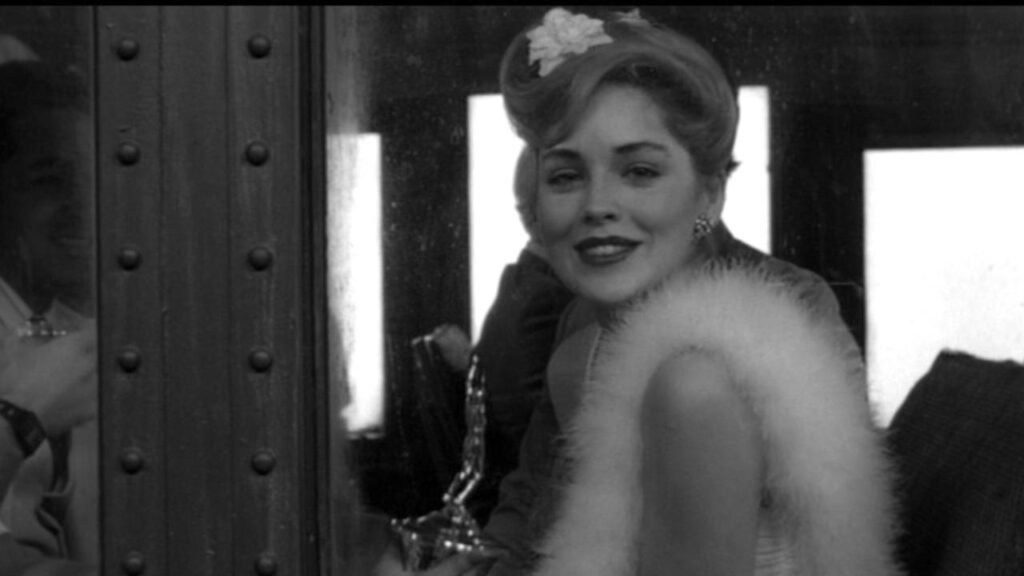
With Annie Hall, the approach was still humorous, but Allen began to experiment with straight comedy (as opposed to goofy comedy), but none of this matters as Allen doesn’t want us to compare him to Bates. He’s scheduled to spend a weekend in an idyllic, coastal New Jersey hotel where his work will be honored.
He’s also dealing with the fallout of one romance, to the unstable yet vivacious Dory (Charlotte Rampling), as well as trying to make his latest relationship work with Isobel (Marie-Christine Barrault) while courting fellow hypochondriac and neurotic bisexual cellist, Daisy (Jessica Harper). Sandy finds himself intrigued and attracted to unstable women. I know what that’s like.
I wonder if that’s his narcissism coming out. Meanwhile, he is beset by fans and studio executives who want him to re-cut his latest movie to make it “more funny.” One of those executives is played by United Artists head Andy Albeck who proclaims at the beginning of the movie, “He’s not funny anymore.” I wonder if that was Albeck’s genuine impression of Stardust Memories, which would be Allen’s last film for the studio before moving to Orion a year later.
Manhattan, 1979 (Woody Allen/Diane Keaton) United Artists
“You have to have a little faith in people.”
My wife and I love New York. We love it because we weren’t born here. I’m from Ohio. She’s from Michigan. We both came to New York separately. We had our baby here. Our daughter is a true New Yorker. She hates New York. She hates it here, and she wants to leave. It makes sense. Every friend I ever had that was a true New Yorker moved to another place. A place with more space.
A place where you need a car to buy a gallon of milk. A place where you get nickel-and-dimed for EVERYTHING. A place where you can’t drink the water. A place where you have to worry about hurricanes and tropical storms on a weekly basis. A place where school shootings are common. My wife and I were born in places like those, but we came to New York, and we stayed.
I’ve lived here over 35 years. I tried to go home again. It didn’t work. Thomas Wolfe was right. The fantasy was dead. Manhattan (and New York) exist as microcosms of the American Experience. This oasis (a difficult oasis, to be sure) that provides for the downtrodden, a beautiful cultural stew rich with diversity. This is my home. I love New York. Non-New Yorkers (and the people who leave) don’t get it, and they never will.
Danny Peary (in his Guide for the Film Fanatic) calls Manhattan a “love poem.” It’s a love poem to a perfect city (populated with imperfect people); an island that is a major character in the movie. It was such a mythological land to me (living in Philadelphia) that as we approached it on our way to our first apartment I was in awe of the skyscrapers and the big buildings sitting on this island, wow!
It’s such a gorgeous city that Woody Allen spends five minutes worshipping it in the intro accompanied by Gershwin’s “Rhapsody in Blue.” This is serious movie magic. The story is a pure soap opera with a ton of one-liners. Everybody plays it straight except for Woody’s Isaac Davis; once again a writer and entertainer of note. He’s in a relationship with 17-year-old Tracy (Mariel Hemingway) when his married best friend, Yale (Michael Murphy) confesses that he’s been having an affair with an overeducated writer named Mary Wilkie (Diane Keaton).
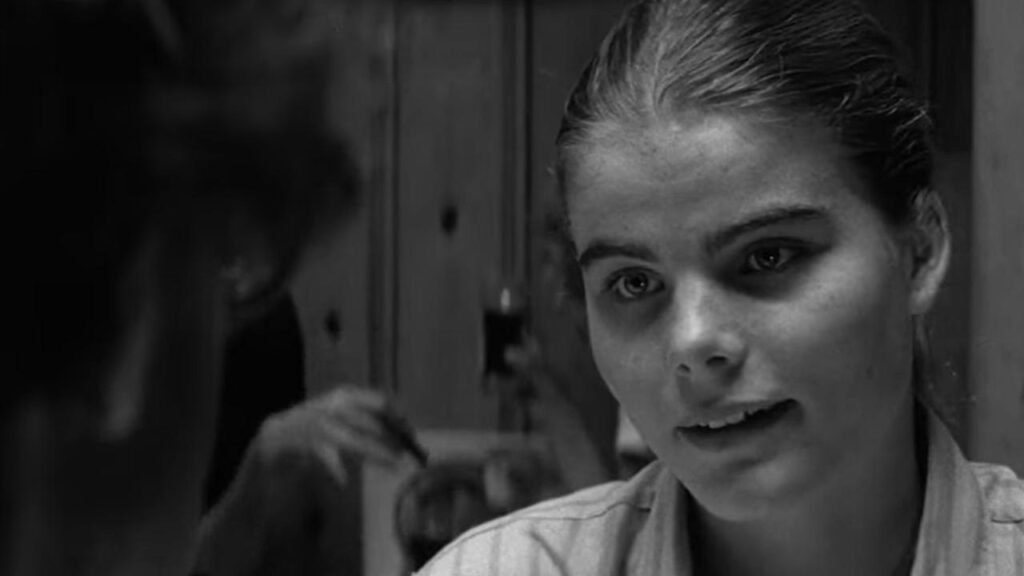
Isaac is shocked because he covets Yale’s stability. After Yale breaks it off with Mary, he encourages Isaac to see her. One of the greatest scenes in any movie ever is Isaac’s gentle break-up scene with Tracy. Mariel Hemingway’s performance blew me away; watching her heart break on camera makes me want to die, and it becomes clear by the end of the movie that, despite her youth, she is a vessel of maturity that makes all the other, supposedly wiser characters look like spoiled brats.
She lost the Oscar that year to her Manhattan co-star, Meryl Streep (for Kramer vs. Kramer). Streep is brilliant, but I think Hemingway should’ve gotten it. She was wonderful. I don’t think Streep was a “supporting actress” in Kramer vs. Kramer. She was a lead. Jane Alexander also received a well-deserved nomination, but that was a supporting actress performance. I never understood that nomination.
1979 was a difficult year for Academy Award nominations. There was an embarrassment of riches unlike today. Isaac is quite possibly the most unlikable character Allen has ever conceived for himself to play. Sandy Bates from Stardust Memories comes a close second. He’s a user; a man who is only alive in his relationships, all of them based in physical attraction and very little else.
His friend, Yale, isn’t much better. While he had taken up the yolk of marriage, he bores easily and jumps back and forth into his infidelity. He’s also such an incredible liar that it’s shocking his wife, Emily (Ann Byrne), can’t see the forest from the trees. After Isaac has pushed Tracy out of their relationship by encouraging her to go to London, he misses her almost immediately after Yale takes up with Mary again.
He begs her to come back just as she’s about to leave for her trip, and now it’s Tracy’s turn to gently dump him by the side of the road. He smiles, knowing she’s right. Manhattan may be Woody Allen’s masterpiece. It was a movie he detested and didn’t want to release. He even offered to work for free on his next project if United Artists deleted the movie. Like Emily, perhaps he’s a filmmaker who couldn’t see the forest from the trees either.
Interiors, 1978 (Diane Keaton/Marybeth Hurt/Sam Waterston) United Artists
“I think you’re really too perfect to live in this world. I mean, all the beautifully furnished rooms, carefully designed interiors, everything’s so controlled. There wasn’t any room for any real feelings. None, between any of us. Except Renata, who never gave you the time of day. You worship Renata. You worship talent. Well, what happens to those of us who can’t create? What do we do? What do I do when I’m overwhelmed with feelings about life? How do I get them out? I feel such rage toward you! Oh mother, don’t you see, you’re not just a sick woman. That would be too easy. The truth is, there’s been perverseness, and willfulness of attitude in many of the things you’ve done. At the center of a sick psyche there is a sick spirit. But, I love you. And we have no other choice, but to forgive each other.”
Who would’ve thought in 1978 that Woody Allen had so much misery tucked away in his psyche that he could craft such a gloomy Bergmanesque, “dark night of the soul” opus called Interiors? As far as I can tell, this is the first time he inflicts bizarre pain, trauma, and dirty tricks on his characters; almost living cathartically through them. He would engage in this kind-of literary attrition for his next movie, Manhattan, and then later on with Zelig and The Purple Rose of Cairo.
This is an almost sadistic exercise. The focus is on three sisters (like Hannah and her Sisters but with no humor): Renata (Diane Keaton), the much-lauded poet, directionless and untalented Joey (Marybeth Hurt), and beautiful actress Flyn (Kristin Griffith). Renata’s husband, Frederick (Richard Jordan) is jealous of his wife’s success. Joey’s boyfriend, Mike (Sam Waterston) is resentful of the close ties Joey seems to have with her clinging, condescending mother, Eve (Geraldine Page).
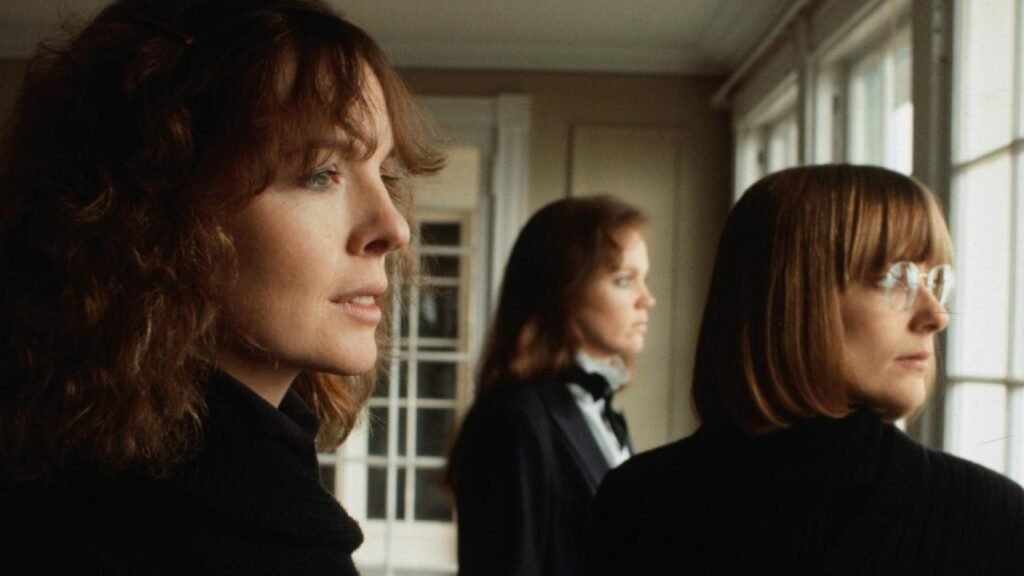
Their father, Arthur (E.G. Marshall) announces he and Eve are separating, possibly divorcing in the future. Eve tries to kill herself, and she is placed in a sanitarium. A short time later, she is released, but she is convinced she and Arthur will reconcile. Meanwhile, Arthur has started dating another woman named Pearl (Maureen Stapleton). Pearl is a breath of fresh air to the family, but Joey takes an instant dislike to her.
It’s interesting how I got wrapped up in these characters’ lives. From outward appearances, Interiors resembles a bland melodrama, but there’s so much more going on. It’s a dense ninety minutes. The performances, all of them, are wonderful, particularly Page.
The sparse production design by Joel Schumacher serves as visual analogy for the family at the center of the story. These are wealthy, privileged intellectuals on the verge of psychosis and breakdown, but you do wonder if the downbeat ending can bring these people any sense of hope and closure. Interiors was nominated for five Academy Awards, but then sadly forgotten.

